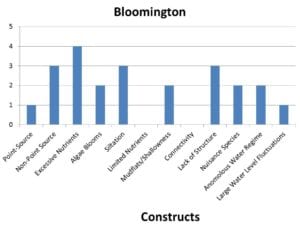The primary problems in Lake Bloomington are that the levels of phosphorus and nitrates/nitrites are too high, sedimentation of the lake is occurring, and quality fish habitat is lacking in parts of the lake.
Lake Bloomington has 55,580 feet of shoreline. Areas of Lake Bloomington shoreline are eroding at significant rates resulting in loss of land and unsightly areas. Three shoreline erosion surveys have been completed in the past twenty years on Lake Bloomington. In 1989, a field reconnaissance survey of Lake Bloomington’s shoreline was completed as part of the Report on Drought Emergency Water Sources and Options to Improve Existing Lake Supplies for the City of Bloomington, IL by Farnsworth & Wylie/Hanson Engineers. Roger Windhorn, NRCS Resource Soil Scientist, also completed a Shoreline study in 1998. The most recent and in-depth analysis was completed in November, 2005 by Midwest Streams, Inc. under contract to the City of Bloomington. The survey shows nearly vertical eroding bank heights ranging from only 1 or 2 feet up to 10 to 12 feet. The project stabilize approximately 1,750 feet of shoreline out of the 2,900 ft. on the north shore.
Poor water quality threatened drinking water supplies of the City of Bloomington, Illinois.

Non-point source pollution and excessive nutrients threatened the quality of the drinking water supply of the City of Bloomington. In addition, siltation reduced storage volume and resulted in poor shoreline fish habitat. The Lake Bloomington Watershed Plan (http://web.extension.illinois.edu/lmw/downloads/22860.pdf) discusses the issues facing Lake Bloomington and its watershed and also proposes solutions to address the issues.